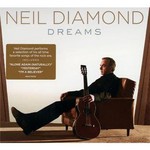Dreams
Studio Album by Neil Diamond released in 2010Dreams review
Diamond is not looking for retirement
Next year, Neil Diamond turns seventy. The Neil Diamond who, as a wonderful author and performer of rock-music, has sold over a hundred and twenty mullion CDs and still gathers sold-out halls. His golden era is long gone and left in the seventies and eighties, when his records were records used to come out regularly and imminently soar to the tops. Nevertheless, Neil’s recent accomplishments leave no right to speak of him as a part of the past. In 2008, after a streak of years of mediocre activity, he released a truly amazing album, Home Before Dark, that had a success comparable to the one gained by its glorious predecessors. No one would dare expect Diamond to do anything like that in the near future, but the artist’s supporters were delighted to know that he was back in the studio. Diamond’s fresh record, bearing an extremely simple title Dreams, is a ser of covers Neil did for well-known numbers which he likes personally.
Voice is what makes Diamond’s style
Among the fourteen tracks off Dreams you will not find those that became hits recently or, on the contrary, those completely unfamiliar to the young and inexperienced part of the audience. Despite the fact, that their original versions were made by absolutely different performers at absolutely different times, Dreams sounds very coherent. The instrumental accompaniment is stripped down to one or two instruments, mostly guitar or piano to highlight the intonations of the voice. It is as clear as day that these songs reached the heart of Diamond once in the part, because now, singing them himself, he saves no emotions. It is interesting to track the history of I’m A Believer, recorded and initially performed by Diamond, but made a true hit by The Monkees. On this album, it is slightly slowed down and has electric guitar replaced for acoustic, apart from the majority of the tracks where Neil resorts to minimum adjustments relying wisely on his voice. This is the singer’s vocal work that strengthens the dramatic touch of the material and even makes sad statements out of originally bright songs.
Neil still believes in his powers
In the past, Diamond was known for providing a whole lot of material to be covered by other performers; and today he comes back to classic songs to make his own interpretations of them. Selection of covers is only a little bit easier than penning one’s own music. You have to consider a great many of aspects, from attractiveness to listeners to fitting your own style. Besides, you can simply spoil the original, especially if you’re dealing with eternal number ones. Neil Diamond is perfectly aware of his potential and, being confident of his abilities, he chose the songs most often covered. It is sufficient to name only Leonard Cohen’s Hallelujah or The Beatles’ smashing Yesterday, and Blackbird. Then, Neil wanted us to see that no matter how many times they have been covered, his versions would be recognizable and preferable. The artist proved right. He sings everything featured on Dreams as if these are his own songs, his own life stories and emotions he once lived. The musician really is in his prime and it is tempting to wait for a number of big works from his after he turns seventy.

